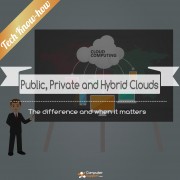3 Ways CIOs Can Remain Relevant in a Cloud-Driven World
The role of IT departments is changing, as businesses increasingly move files and applications to the cloud. Once IT staff are no longer called upon to install software or restore a file from server backup, the entire department could suddenly find itself with extra time on its hands.
In actuality, though, CIOs are finding their roles are rapidly changing within the corporate structure. Instead of being a separate entity, tasked with completing help desk tickets and changing backup tapes, IT now finds itself becoming a liaison between business leaders and third-party service providers. This is a much more high profile role that often intensifies longstanding relationships between CIOs and other upper-management staff within the organization. Here are three major ways CIOs can help their teams remain relevant in the new cloud-driven marketplace.
Cloud Services Facilitation
When dealing directly with cloud vendors, CEOs and CFOs are often presented with a variety of options. A CIO can work with both the vendor and business leaders to ensure that choices are in line with business goals. Such decisions as whether to go public or private with a cloud move, whether a particular SaaS application will meet compliance requirements, or negotiating SLAs often require the advice of an expert who knows both the business and technology sides of things.
Business Partnerships
In this new frontier, CIOs are increasingly finding themselves working side by side with CEOs and CFOs as they drive the direction of the organization. Tasks like creating disaster recovery plans should involve leaders from multiple departments as they work together to prepare for an event that would have an impact on the entire organization. In this sense, CIOs are being seen more as business partners than user support.
Project-Driven Leadership
Offloading mundane tasks to the cloud allows CIOs and their teams to focus more intently on projects than day-to-day IT operations. Technology has become so closely interwoven with business operations that it’s difficult to separate the two. CIOs may find themselves working with team leaders to find an app that will make field operations more efficient or to oversee the creation of a mobile app that will reach out to customers.
These exciting changes present opportunities to those who have forged a career in information technology. By finding ways to work with business leaders, CIOs can redefine their own roles within their respective organizations, ensuring their longevity.




